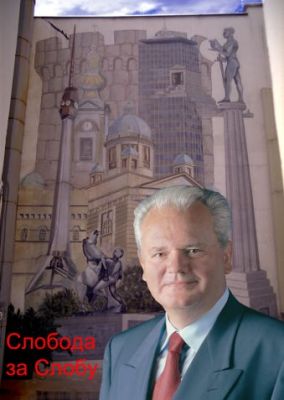 As you can imagine, I froze when I read the following passage in the Los Angeles Times story from Belgrade about the tensions caused by memorial rites for former Yugoslav President Slobodan Milosevic. Reporter Alissa J. Rubin described this scene:
As you can imagine, I froze when I read the following passage in the Los Angeles Times story from Belgrade about the tensions caused by memorial rites for former Yugoslav President Slobodan Milosevic. Reporter Alissa J. Rubin described this scene:
Milosevic's coffin sat alone in a large, white-walled exhibition hall, where the museum lately has displayed avant-garde art. It rested on a table in the middle of the room, a large framed photograph of Milosevic leaning against it.
As people filed by, many crossed themselves and then kissed the photo's frame as they would an icon in a Serbian Orthodox church. The mood was somber but resigned -- in many ways Milosevic died here in Serbia in 2001, when the deposed leader vanished from public view.
This image would seem to blend well with the following statement in the new Reuters wire service report that is available all over the place on the World Wide Web:
The Serb Orthodox Church, which backed Milosevic's hardline brand of nationalism, will hold a funeral ceremony in Pozarevac, something of a surprise for a man who was not thought to be religious.
This short piece offers no information to back up that stunning statement, which would certainly be a shock to the Orthodox that Milosevic's Communist thugs jailed, assaulted or killed through the years. It would certainly be a shock to the bishops who led public efforts to overthrow his regime.
Watch the coverage this weekend for references to Patriarch Pavle, the key figure in Serbian Orthodoxy. Watch to see what he says and does.
Anything -- repeat ANYTHING -- involving religion in the Balkans is going to be emotional and complex beyond coverage in a 600-word newspaper report. What I fear today (yes, I am Orthodox) is that any Orthodox presence in events linked to this butcher's passing will be, through television images, primarily, be used to suggest that the church supported this man.
There were bishops or priests who, as clergy often do, were involved in scenes in which they blessed troops going into combat. There are millions of people who were nationalists in Serbia who also are, to one degree or another, Orthodox. The church will probably grant the family a funeral. But I hope that, at some point, journalists can actually dig into the reality of all that Milosevic did to persecute religious believers and all that the religious leaders in the region -- led by Orthodox bishops -- did to oppose him and plead for peace.
If you want to read more about that, click here, here and finally here. Note, in particular, the efforts by leaders in Europe and America to ignore pleas for peace and nonviolence that came from a remarkable coalition of Orthodox, Catholic, Jewish and Islamic leaders in, of all places, Kosovo.
In the end, so many of these stories return to the horror of Kosovo and how Milosevic manipulated Serbian emotions about that region, soaked in centuries of blood and sacred history. I put it this way in a 1999 column:
Since morphing from Communist to nationalist, Milosevic has skillfully used Serbia's array of fears, hatreds and resentments to justify terror in Kosovo and elsewhere by his paramilitary and police units. The Serbian strongman knows that Kosovo contains 1,300 churches and monasteries, many of them irreplaceable historic sites.
Retired New York Times editor A.M. Rosenthal, who once won a Pulitzer Prize for his reporting in Eastern Europe, put it this way: "I do not get emotional about the history of Kosovo. I am not a Serb. Serbs do. ... Serbs are as likely to give up Kosovo willingly because the Albanians want it as Israelis are to give up Jerusalem because the Arabs want it."
If you want to know more about that, click here and see some photographs from the past few years. Yes, the butcher of Belgrade knew where to light a match in order to cause an explosion.
Please help me look to see if any of this weekend's reports try -- for better or for worse -- to cover these issues with any sensitivity or depth.
